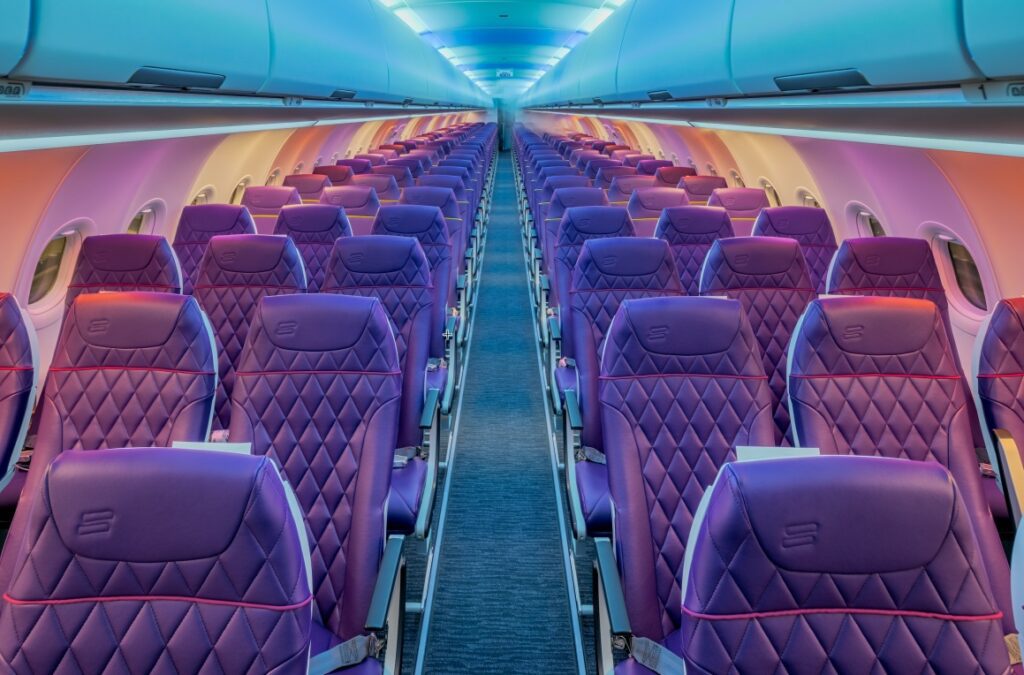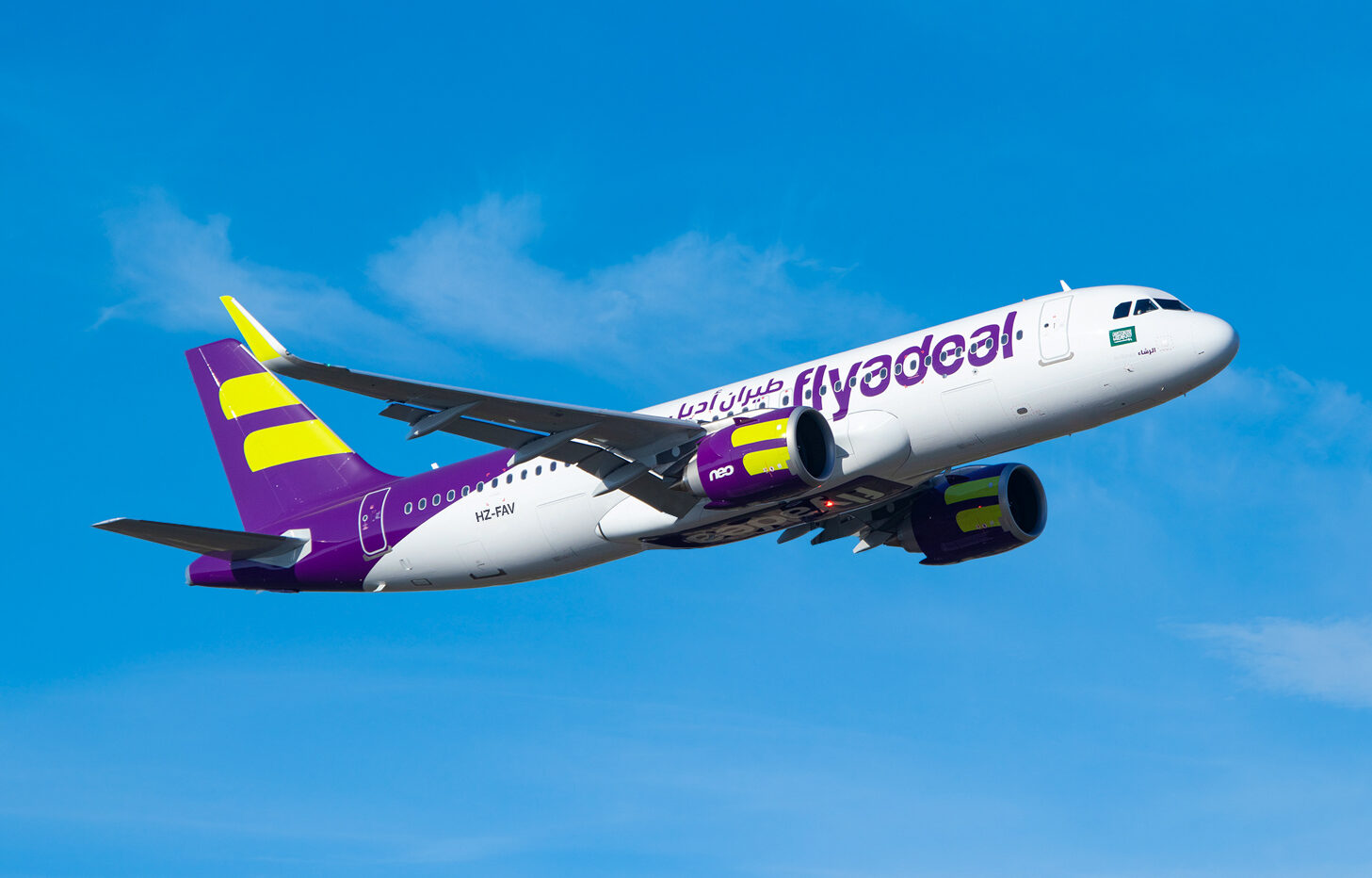Even by Saudi standards, the goals are ambitious: By 2030, the country wants 330 million passengers to pass through its airports annually, up from around 112 million last year.
To get there, the Saudi airline sector is growing faster than almost anywhere on the planet.
New carrier Riyadh Air has grabbed most of the attention. However, there’s another shift underway: The rise of the Saudi low-cost airline.
Flyadeal is the budget subsidiary of Saudia, the country’s national carrier. Since launching in 2017, it’s grown to become one of the nation’s biggest low-cost operators.
By the end of the decade, flyadeal is set to triple in size, from 32 planes today, to almost 100. Dozens of new destinations are set to be added to its route map, with international links into Europe and the Indian subcontinent.
Trying to take this vision from spreadsheet to the skies is Steven Greenway, who was appointed flyadeal CEO in January. He was a founding member and CCO of Scoot, Singapore Airlines’ budget subsidiary, and also served as president of Swoop, a Canadian ultra-low-cost carrier that later merged with WestJet.
While the opportunities for Greenway are vast, so are the challenges. Adding huge capacity into a developing market in a short space of time can be difficult.
In the latest of our Leaders of Travel: Skift C-Suite Series, we sit down with Greenway to find out how ambitions can translate to reality.
Which Planes Will Fuel the Expansion?
Skift: Before you joined flyadeal, there was a publicly shared goal of having around 100 planes in the fleet by the end of the decade. Is that still on the cards?
Steven Greenway: Yes. The ambitious growth plan at flyadeal was the reason I was attracted to the airline. You’re going to see us leapfrog from 32 aircraft today to just shy of 100 in four or five years – more than tripling in size.
Our background is domestic flying and this still makes up around 80% of our capacity. Moving forward, the dynamics will change slightly because we’ll continue to grow domestically, but also branch out internationally. The airline is morphing into more of an equal blend of domestic and international flying.
We know that the additional 65 or so aircraft will be Airbus narrowbodies. Do you have any wiggle room regarding the size and variant?
The order book is a mix of Airbus A320s and A321s. I can’t talk about what the actual mix is, but our A321s start arriving in 2026. It’s that well-worn strategy seen in other parts of the world wherever you have slot constraints where you deploy the A321 to give you extra capacity. But it’s also about enabling us to grow with what we have.
There are only so many times you can fly between Riyadh and Jeddah. We already have 22 flights a day. You can add another one every 15 minutes, you can use that slot for something else like an international service, or you can upgauge the size of the aircraft.
The mission set between the A320 and A321 is exactly the same, it’s just that we’re getting more seats. It offers flexibility in a part of the world where there’s a lot of seasonality. There are peaks and troughs in terms of demand. Of course, that’s true for a lot of markets, but particularly here in the Middle East.
Taking a look inside the plane, would you consider introducing a hybrid premium product like we’ve seen at other low-cost carriers?
I’ve worked at airlines that have done both. However, in my mind the premium cabin really only comes into play after four or five hours. We’re comfortable with the product we have. We’re constantly upgrading the seats, installing huge overhead bins, and offering in-seat power. When you consider all of these things combined, there’s enough there that people are reasonably comfortable for the mission sets that we have for the aircraft.


An Increasingly Familiar Business Model
How responsive is the Saudi market, and consumers more generally in the region, to the low-cost carrier (LCC) concept?
Saudi Arabia is as commercialized as any country in Europe. They get what the trade-off is. You have airlines like Wizz coming into the country, Air Arabia, you have us. We all have similarly common practices with unbundled fares, so it’s nothing unfamiliar to this market.
You have Saudia at the top offering full service, you have flynas in the middle doing a hybrid, and you have us doing a pure LCC play. People have choices in the market, which is great. They get what the proposition is, it’s not something that you have to educate them on per se.
Are there any areas where further progress could be made?
I think the things that we need to improve are more around customer service and expectations. In some countries and regions, online check-in can be between 90-99%. It’s not here. Online check-in is not anywhere near as high as we would like, but it is progressing in the right way.
People also still carry a lot of baggage. For example, in Europe, people are able to survive with a backpack for the weekend because they want to save the money. That’s their choice. Here it’s a slightly different market, but it is adapting.
Flyadeal’s Growth Trajectory
Flyadeal plans to operate to more than 100 destinations by 2030. What are the key markets and geographies to watch?
The country is opening up for both domestic and inbound tourism. What you have is Saudis discovering Saudi Arabia. It’s not that they couldn’t travel around before, it’s that there simply wasn’t that mobility five or ten years ago.
I read the other day that Riyadh to Jeddah is probably going to be the busiest route in the world in the next couple of years – it’s come out of nowhere.
But there’s a lot more expansion to do within Saudi Arabia, especially when you look at the mega projects that are opening up. One good example is the Red Sea resorts. A new airport has opened there and it’s not even on our route map at the moment. It’s certainly something that we’ll be looking at over the next couple of years.
And what about your international ambitions?
India is of incredible interest to us. The UAE and the Middle East in general are still underserved in terms of points into and out of Saudi Arabia. We also have to consider the secondary points. Everyone speaks about Riyadh and Jeddah, but what Dammam, what about Madinah? For example, we might already be operating to Dubai from Riyadh but we’re not from Madinah. So we’ll start joining the dots on that type of route as well.
And then there’s southern and southeast Europe. We really haven’t touched on that except for some summer seasonal flying, which has been successful. But getting in there and branching into that market is a huge opportunity for us as well.
We’ve seen other low-cost airlines in the region and further afield open foreign subsidiaries. Is this of interest to you?
Never say never, but it’s really not on our radar. The reason is we believe in so much potential in Saudi Arabia that we don’t have to go fishing. Typically it happens when you’re a city-state, you’ve got no domestic market, you’re a pure international player – therefore you’re looking for other markets to open up. We’re not in that position.
We have a 10-year fleet plan, we know where the aircraft are going to go – obviously subject to change – and all of those are going into the Saudi market, either domestically or internationally.


The Future of Flying
Before joining flyadeal you were involved in the AI space. How much scope is there for this technology in the airline industry?
I think there’s huge potential. The question is does it replace human thinking and decision making? Or does it supplement and support and provide insight? I think there’s a lot of hype out there and that question still hasn’t been answered. I see AI as a companion to decision-making to support a whole range of factors.
Everything from call centers to network planning to operations control. We’re putting in scenarios, and we’re getting back a range of options that we can make decisions on as a business – that’s where we are experimenting as an airline.
And finally, what are your key trends to watch for the coming year?
The continued growth, or boom, in Saudi Arabia. Watch how it manifests itself. You’ll also continue to see the Kingdom shape what its ambitions are. Keep an eye out for that because some of the things that are coming online, or to be announced, are absolutely phenomenal. I can’t speak about them, but I certainly know what’s coming and I think this is going to be a very interesting market.
This interview was edited for clarity and length.
Read more from our new Leaders of Travel: Skift C-Suite Series here.
Airlines Sector Stock Index Performance Year-to-Date
What am I looking at? The performance of airline sector stocks within the ST200. The index includes companies publicly traded across global markets including network carriers, low-cost carriers, and other related companies.
The Skift Travel 200 (ST200) combines the financial performance of nearly 200 travel companies worth more than a trillion dollars into a single number. See more airlines sector financial performance.

